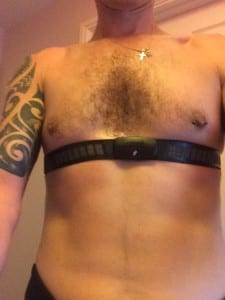Welcome to a weekly feature on my blog – Ben’s Zone. Written by husband… Ben. A foodie, coffee obsessed, ex-smoking, ex-drinking and Ridgeback loving Dad. Who is also seriously into his fitness. You can find him on the blog (most) Sundays. Enjoy 🙂
Training with a Heart Rate Monitor
For the last two years, virtually every serious piece of exercise I have done has been measured using a heart rate monitor (HRM). In this post I’m going to discuss why I do this, the advantages as I see them and the options available if you’re thinking about getting one.
So, first up, let’s look at the types available. The most traditional type of heart rate monitor uses a chest strap to measure the electrical impulses from your heart and from this infer your heart rate. Recently a more modern type of sensor has arrived on the market which uses light pulses to measure heart rate in your wrist.
The Apple iWatch is a well known example of this type though the technology has been used in TomTom watches and the new Garmin Forerunner 225. Some people will say that the optical type of sensor is less accurate on a wrist, than a chest strap, opinion varies on this, sports watch tester par excellence DC Rainmaker reviewed the latest Garmin offering and found the optical sensor more accurate than their HRM run chest strap. For me it comes down to what you prefer and what you find convenient. I use a Garmin HRM run chest strap linked to my Fenix 3 sportswatch. In all scenarios you will need something to record and interpret the heart rate data, in most cases this will be a sportswatch though some would connect to a smartphone.
There are a lot of options out there and I believe it’s a case of finding the one that suits you. I love my Fenix 3 as it offers superlative GPS functions and looks just about acceptable as a day to day watch, but it was an extremely expensive option (for me at least). You’ll also need a means of viewing and interpreting the data, there are free smartphone apps to do this, software that comes with your device or the excellent Garmin Connect application is available for free to users regardless of what device they use. One thing I would say in relation to chest straps is to find one where the monitor can be detached and the strap washed if possible. It does not take long for the strap to become really rather unpleasant.
Garmin HRM Run type chest strap heart rate monitor on Amazon
What Do I Use A Heart Rate Monitor?
So why do I track my heart rate? At the heart of it I love the data and find that I can use the data to motivate myself when working out. With heart rate information it is possible to imply a measures of Cardiovascular fitness such as VO2 Max and also measure how effective workouts have been via calculations such as Training Effect. Both of these are estimations and so by definition are not the whole picture but it helps me to see if I am progressing in my training and also to see what is working and what is not working in my exercise plans.
Another good reason for me to track heart rate is that it helps me to keep my nutrition in check. My goal, at the moment, is to maintain my current weight and so I use MyFitnessPal to track the calories I take in. When I have done a good cardiovascular workout I need to make sure that I fuel up properly again. Not overeating and causing myself an issue (that issue being pull ups getting harder), but making sure that I get the right nutrition to keep from crashing at work.
My final reason for tracking heart rate is so that I don’t over train. It’s a pretty simple process to measure resting heart rate and after having calculated maximum heart rate set zones to train in. The mythical ‘fat burning zone’ is exactly that, a myth. Technically your body burns most fat when you’re sitting on the sofa, but what is a very real thing is the damage you can do pushing your heart rate too high for too long. Heart rate zones give an idea of where your limits should lie and often can be configured to sound alarms when you are exceeding safe limits. There’s a point with exercise when your body is spending so much time repairing itself that it cannot build back stronger, so the workout is useless, heart rate zones can help avoid that.
Watch display with heart rate shown on bottom right (73bpm)
By entering resting and maximum heart rate bands are calculated. A visible and audible warning is given when the maximum band is breached.
It’s true that in a broad sense an athlete can use things such as time measurement to get a general idea of the effort that’s going in to a workout but how does that work when you’re on a treadmill or cross trainer? Can this account for tiredness or feeling under the weather? The simple answer is that to accurately manage cardio input, measurement of heart rate is one of the most effective and accessible tools you can add in to your workout. Considering that this can be had for a few months of gym membership or a couple of dustbin sized pots of protein powder, why aren’t you doing it?
*Please note this post contains affiliate links.





I haven’t done this before but I have been thinking about using one – useful post thanks! #FitnessTuesday
I find it invaluable, I had to go to the USA on business recently and I even took it over there.
Since getting my Apple Watch I have definitely found it easier to be motivated. I’m able to see my heart rate at a glance. I love it. Thanks for sharing.
#FitnessTuesday
An Apple watch? Very swish! I think the fact that Apple have included heart rate monitoring on their watch indicates that it’s not just something that really extreme athletes can benefit from but something we can all use.